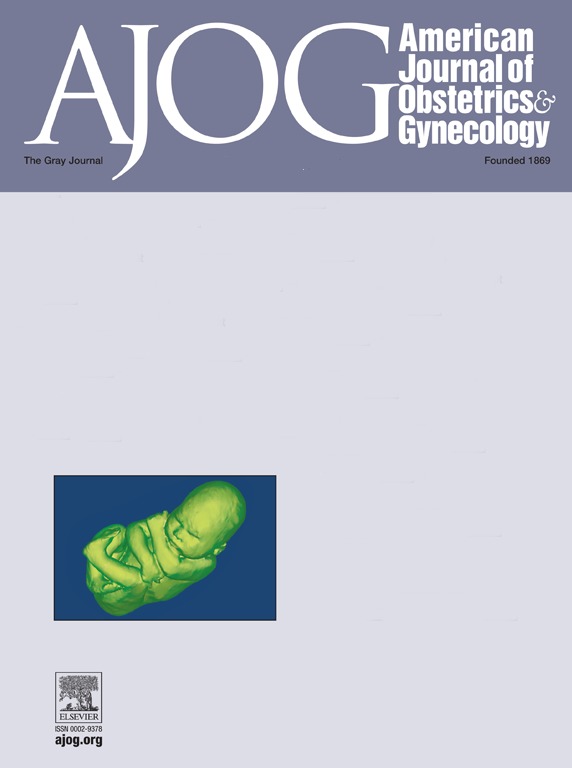TUBA-WISP-II研究中乳腺癌病史对卵巢癌降低风险手术决策的影响
IF 8.4
1区 医学
Q1 OBSTETRICS & GYNECOLOGY
引用次数: 0
摘要
背景:女性BRCA1/2致病变异携带者患乳腺癌和卵巢癌的风险增加。在TUBA-WISP II研究中,女性选择标准的降低风险的输卵管卵巢切除术或降低风险的输卵管切除术并延迟卵巢切除术来预防卵巢癌。在纳入研究时,相当大比例的女性有乳腺癌病史,这可能会影响决策。目的:本研究旨在描述有乳腺癌病史的女性与无乳腺癌病史的女性在降低风险手术的类型和时机方面的决策。研究设计:绝经前BRCA1/2致病变异携带者完成了关于其个人病史和首选风险降低策略的网络调查问卷。评估了有乳腺癌史和无乳腺癌史的妇女首次降低风险手术的类型和时间的差异。本研究通过多变量分析,对有乳腺癌病史的女性选择降低风险的输卵管卵巢切除术的个人、环境和乳腺癌相关特征进行了研究。结果纳入1676名女性,其中222名(13.2%)有乳腺癌病史。其中77.0%的人选择了RRS/DO,而无乳腺癌病史组的这一比例为78.0% (p=0.73)。在诊断出BRCA1/2之前患有乳腺癌的个体比同时诊断或首次诊断出BRCA1/2的女性进行第一次手术的中位时间晚2年。在指南年龄范围内诊断为乳腺癌的女性(35-40 BRCA1, 40-45 BRCA2)比指南年龄范围前的女性更常选择降低风险的输卵管卵巢切除术,优势比为6.2 (95%CI 1.9-19.9)。结论:乳腺癌病史与特定降低风险策略的偏好无关。在指南年龄范围内诊断为乳腺癌的女性比在指南年龄范围前诊断为乳腺癌的女性更常选择降低风险的输卵管卵巢切除术。本文章由计算机程序翻译,如有差异,请以英文原文为准。
Impact of breast cancer history on decision-making for ovarian cancer risk-reducing surgery in the TUBA-WISP-II study.
BACKGROUND
Female BRCA1/2 pathogenic variant carriers have an increased risk of breast and ovarian cancer. In the TUBA-WISP II study, women choose between standard risk-reducing salpingo-oophorectomy or risk-reducing salpingectomy with delayed oophorectomy to prevent ovarian cancer. At inclusion, a significant proportion of the enrolled women had a history of breast cancer, which could impact decision-making.
OBJECTIVE
This study aimed to describe decision-making regarding type and timing of risk-reducing surgery among women with versus without a history of breast cancer.
STUDY DESIGN
Premenopausal BRCA1/2 pathogenic variant carriers completed web-based questionnaires on their personal histories and preferred risk-reducing strategy. Differences in type and timing of first risk-reducing surgery in women with versus without a history of breast cancer were assessed. A multivariable analysis was conducted to examine personal, environmental, and breast cancer related characteristics associated with the choice for risk-reducing salpingo-oophorectomy among women with a history of breast cancer.
RESULTS
We included 1676 women, of whom 222 (13.2%) had a history of breast cancer. Of those, 77.0% chose RRS/DO, compared to 78.0% in the non- history of breast cancer group (p=0.73). Individuals with breast cancer before their BRCA1/2 diagnosis had their first surgery median 2 years later than women who were diagnosed simultaneously or had their BRCA1/2 diagnosis first. Women diagnosed with breast cancer within the guideline age range for completing risk-reducing salpingo-oophorectomy (35-40 BRCA1, 40-45 BRCA2) more often chose risk-reducing salpingo-oophorectomy than women before the guideline age range, odds ratio 6.2 (95%CI 1.9-19.9).
CONCLUSION
A history of breast cancer was not associated with preference for a specific risk-reducing strategy. Women diagnosed with breast cancer in the guideline age range more often chose risk-reducing salpingo-oophorectomy than women diagnosed before the guideline age range.
求助全文
通过发布文献求助,成功后即可免费获取论文全文。
去求助
来源期刊
CiteScore
15.90
自引率
7.10%
发文量
2237
审稿时长
47 days
期刊介绍:
The American Journal of Obstetrics and Gynecology, known as "The Gray Journal," covers the entire spectrum of Obstetrics and Gynecology. It aims to publish original research (clinical and translational), reviews, opinions, video clips, podcasts, and interviews that contribute to understanding health and disease and have the potential to impact the practice of women's healthcare.
Focus Areas:
Diagnosis, Treatment, Prediction, and Prevention: The journal focuses on research related to the diagnosis, treatment, prediction, and prevention of obstetrical and gynecological disorders.
Biology of Reproduction: AJOG publishes work on the biology of reproduction, including studies on reproductive physiology and mechanisms of obstetrical and gynecological diseases.
Content Types:
Original Research: Clinical and translational research articles.
Reviews: Comprehensive reviews providing insights into various aspects of obstetrics and gynecology.
Opinions: Perspectives and opinions on important topics in the field.
Multimedia Content: Video clips, podcasts, and interviews.
Peer Review Process:
All submissions undergo a rigorous peer review process to ensure quality and relevance to the field of obstetrics and gynecology.

 求助内容:
求助内容: 应助结果提醒方式:
应助结果提醒方式:


